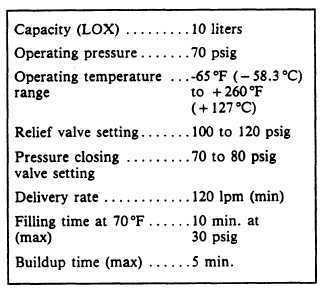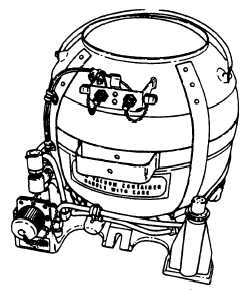Table 12-16.—Leading Particulars for Liquid Oxygen Con-
verter Assembly, Type GCU-24/A, P/N 10C-0016-10
Figure 12-5.—Liquid oxygen
GCU-24/A, P/N
converter assembly, type
1OC-OO16-1O.
liquid oxygen quantity gauge located in the air-
craft, is incorporated within the sphere assembly.
The quantity gauge indicates the amount of LOX,
in liters, contained in the converter.
Operation and performance characteristics of
the GCU-24/A converter assembly (P/N
10C-0016-10) are as follows:
1. The converter is filled by attaching the
LOX servicing trailer filler valve to the filler port
of the fill, buildup, and vent valve on the
converter. When attached, the servicing trailer
filler valve depresses the nosepiece and valve
poppet of the fill, buildup, and vent valve. This
automatically puts the converter into the fill mode
(fig. 12-6). Figure 12-7 shows the converter
installed in an aircraft.
2. With the poppet depressed, the fill and vent
ports of the valve are opened, and the buildup
port is closed. This condition allows gas pressure
built up in the inner sphere to vent to the
atmosphere. As pressure is vented, LOX in the
servicing trailer (which is at a greater pressure-30
psig), flows through the fill, buildup, and vent
valve and into the converter.
3. As the LOX level rises in the sphere,
pressure created by vaporization of liquid due to
heat, turbulence, etc., is vented to the atmosphere.
The converter is considered full when LOX flows
in a steady stream from the overboard vent line
quick disconnect.
4. When the converter is full and the servicing
trailer filler valve is disconnected, the nosepiece
and poppet of the fill, buildup and vent valve
return to the extended position (fig. 12-6). This
automatically puts the converter into the buildup
and supply mode by closing the fill and vent ports
of the vaIve, and opening the buildup port.
5. In the buildup and supply mode (fig. 12-6),
LOX is forced out of the bottom of the inner
sphere and into the buildup coil by the weight of
the liquid. As the LOX warms and vaporizes
into gaseous oxygen in the buildup coil, pressure
is created. This pressure is controlled at
approximately 75 psig by the opening and closing
action of the pressure closing valve.
6. Gaseous oxygen travels from the buildup
coil through the supply quick disconnect and the
heat exchanger to a shut-off valve in the aircraft
cockpit.
7. Gaseous oxygen, under pressure, also
passes through the gas and buildup ports of the
fill, buildup and vent valve to the upper portion
of the pressure closing valve, within which is a
bellows. This bellows holds the valve in the open
position. As pressure builds, the bellows, which
senses the increase, contracts (at approximately
75 psig), and closes the valve.
8. Without a demand being placed on the
converter, pressure continues to slowly rise. If
12-19




